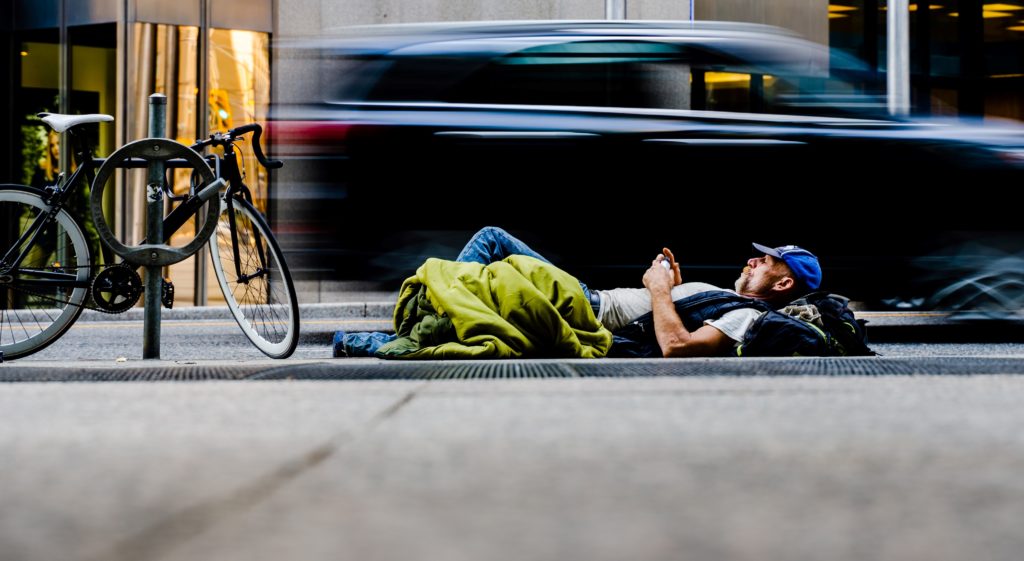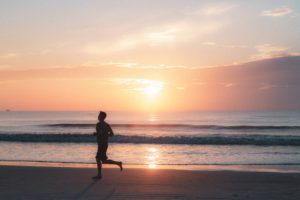Urban cycling is popular in many cities including Vancouver, but little is known about socioeconomically disadvantaged cyclists who ride out of necessity. Findings from interviews with cyclists living in Vancouver’s Downtown Eastside suggest that participants ride for a range of reasons yet face common experiences of stigma. Work remains to incorporate the needs of all cyclists into public policy and urban development.
The Cycling Paradox
Cycling is often touted as an economical, healthy, and sustainable form of transport in public policy and academic literature (City of Vancouver, 2018, Buehler and Pucher, 2012). However, some research has suggested that the health, environmental, and economical benefits of cycling are reserved for privileged populations, and that socioeconomically disadvantaged folks often cycle out of necessity, not by choice (Lugo, 2018). For example, an affluent person might choose to cycle as part of a commitment to living a ‘car-free’ or ‘car-light’ lifestyle, but someone without the economic means to own a car might cycle because it’s one of few transportation options (Hoffman, 2016). With this background, a current study explored what cycling means to a population of socioeconomically disadvantaged cyclists who live in the Downtown Eastside of Vancouver, Canada.
Vancouver is a bike-friendly city with a large population of very wealthy people, but it’s also home to “the poorest postal code” in North America, a neighbourhood known as the Downtown Eastside (Fast & Cunningham, 2018, p. 237).
Situating the Current Study
The current study is based on interviews with five men who live in the Downtown Eastside and cycle regularly. A qualitative research method known as mobile interviewing, where the participant and researcher cycled while conversing, was employed.
Research questions included:
- What does bicycling mean to participants?
- What formal and informal resources do participants use to support their cycling-enabled day-to-day activities?
- To what extent do participants experience stigma related to cycling?
Three main findings emerged from interviews:
- Meanings associated with cycling varied among participants and they used bicycles for a range of reasons;
- Participants navigated a network of bike-related places and had established relationships with people who helped them meet bicycling-related needs; and
- Participants experienced stigma and surveillance related to cycling.
Cycling for Work, Leisure, Transport, and Mobility (6)
Participants cycled for different reasons, and cycling meant different things to each. Three of the men interviewed cycled as part of their work as ‘binners’ or ‘recyclers’—meaning, they collected recyclable materials and exchanged them for money at bottle depots. For them, the bicycle was a utilitarian part of their work. One participant was a leisure cyclist who rode for enjoyment. Another participant used his bike for transport around the Downtown Eastside.
Most cycling scholarship focuses on commuter or recreational cycling (Mayers & Glover, 2020), so it was interesting that cycling for work was a major part of some of these socioeconomically disadvantaged cyclists’ lives. Another notable shared reason for cycling involved mobility. Four of the participants were in their fifties, and part of the reason they chose to ride was because it was easier than walking.
“I can ride my bike a hundred miles a day, but I can only walk a couple blocks before I start crippling up”.
‘George’
As populations in Canada continue to age, cities could benefit from acknowledging and investigating the range of cyclists who use the bicycle not just for general health but as a means to avoid exacerbating existing health challenges, and for mobility in a variety of settings.
Important Places: Trap Lines and Community Bike Shops
The second finding related to the network of ‘underground’ places that participants frequented for their bike-related needs. A number of places were important, including trap lines and community bike shops. Trap lines, the established and routine routes that recyclers collected recyclables on, offered important places of connection. The recyclers had secured important connections with business owners and property managers in order to obtain a regular supply of recycled items from various buildings and businesses along their trap lines. ‘Simon’ explains how recyclers show respect not only for the territory of each other’s trap lines, but also the businesses on their trap lines:
“Everybody knows [one another], everybody has their owns spots and that, and businesses that they do, and nobody touches that, ‘cause they know who does them, right. …nobody does [my spot], unless they see that I’m not here then it’s ok, right, they’ll do it. But for three years I’ve missed it twice here.”
‘Simon’
Using a bike to get to these places on one’s trap line, where people would be expecting participants to pick up their recycling on a given day, was key. Since the recyclers relied on their bicycles to make their businesses run, it was crucial that their bikes remained in working condition. For this, recyclers frequented the community bike shops of Vancouver for their repair needs.
While all the participants were adept at working on their own bikes and one participant had even built his own bike up from the frame, when they needed parts or had major repairs that needed to be done, the community bike shops offered flexibility and affordability. For example, ‘Pete’ explained how a community bike shop offered a credit for a new tube, so he could pay them back when he was able. Squaring up with them when he received his cheque, “kept me on the road for quite a while”, he said.
Experiences of Stigma and Surveillance while Bicycling (7)
While participants had established positive social connections with people along their trap lines and at community bike shops, they regularly experienced verbal harassment and stigma related to cycling from members of the general public and from police.
One way that police communicated they were surveilling participants was by handing out tickets and warnings for relatively minor infractions. Vancouver has cycling legislation that includes a helmet law, a law prohibiting cyclists from riding on the sidewalk, and a law mandating that cyclists must have lights on their bike past sunset (Government of BC, 2020). Participants described being street-checked and ticketed for breaking these laws – laws that could be considered quite minor and that may not be enforced outside of the DTES.
Besides the police, sometimes fellow motorists made stigmatizing comments. ‘George’ described such an instance:
“This is where people say, ‘you should join the circus’. Yeah, I get a lot of that. [People] will FOLLOW me and honk, and say, ‘get off the road’, where am I supposed to go? And people do that, honk, and say, ‘get outta the way, get outta the way’, and I’m like, ‘well, where do I go?’”
Here George describes being insulted and then being told he doesn’t belong on the road. Riding the bike on the sidewalk was not an option due to it being both illegal and not wide enough for recyclers’ loads. Yet some motorists felt it necessary to make sure George knew he was not welcome on the road.
Conclusion
In sum, this study shed light on cyclists in the Downtown Eastside who face stigma, yet are enacting lifestyles more ‘green’ than most Vancouverites despite facing a host of challenges related to living in poverty. If cities including Vancouver aim to really go green, they will need to acknowledge the needs and contributions of people from all socioeconomic standings, not only from cyclists who are going ‘car-free’.
About the Author
Jeanette Steinmann is a Ph.D student at UBC. You can find her on Twitter @jvsteinmann.
References
- Buehler, R., & Pucher, J. (2012). Cycling to work in 90 large American cities: new evidence on the role of bike paths and lanes. Transportation, 39(2), 409-432. https://doi.org/10.1007/s11116-011-9355-8
- City of Vancouver. (2018). Transportation 2040 moving forward. https://vancouver.ca/files/cov/transportation-2040-plan.pdf
- Fast, D., & Cunningham, D. (2018). “We don’t belong there”: New geographies of homelessness, addiction, and social control in Vancouver’s inner city. City & Society, 30(2), 237-262. https://doi.org/10.1111/ciso.12177
- Government of British Columbia (2021). Cycling restrictions, regulations, and rules of the road. https://www2.gov.bc.ca/gov/content/transportation/driving-and-cycling/cycling/cycling-regulations-restrictions-rules
- Hoffmann, M. L. (2016). Bike lanes are white lanes: Bicycle advocacy and urban planning. Lincoln, NB: University of Nebraska Press.
- Lugo, A. (2018). Bicycle/race. Transportation, culture, and resistance. Portland, OR: Microcosm Publishing.
- Mayers, R. F., & Glover, T. D. (2020). Whose lane is it anyway? The experience of cycling in a mid-sized city. Leisure Sciences, 1-18. https://doi.org/10.1080/01490400.2018.1518174






This Post Has One Comment
As a cyclist this article is truly insightful and saddening. From my personal experience, my surrounding community has always made me feel included and supported as a cyclist. On a daily basis cars respect my space and even go to the extent to provide me additional space in order to assure my safety. Due to my privilege and easy access to higher end cyclist gear I have failed to notice the marginalization that experience other fellow cyclists. From now on I will take notice and help out even with something as simple as a giving out tubes to help them feel more supported within our cyclist subculture
Comments are closed.